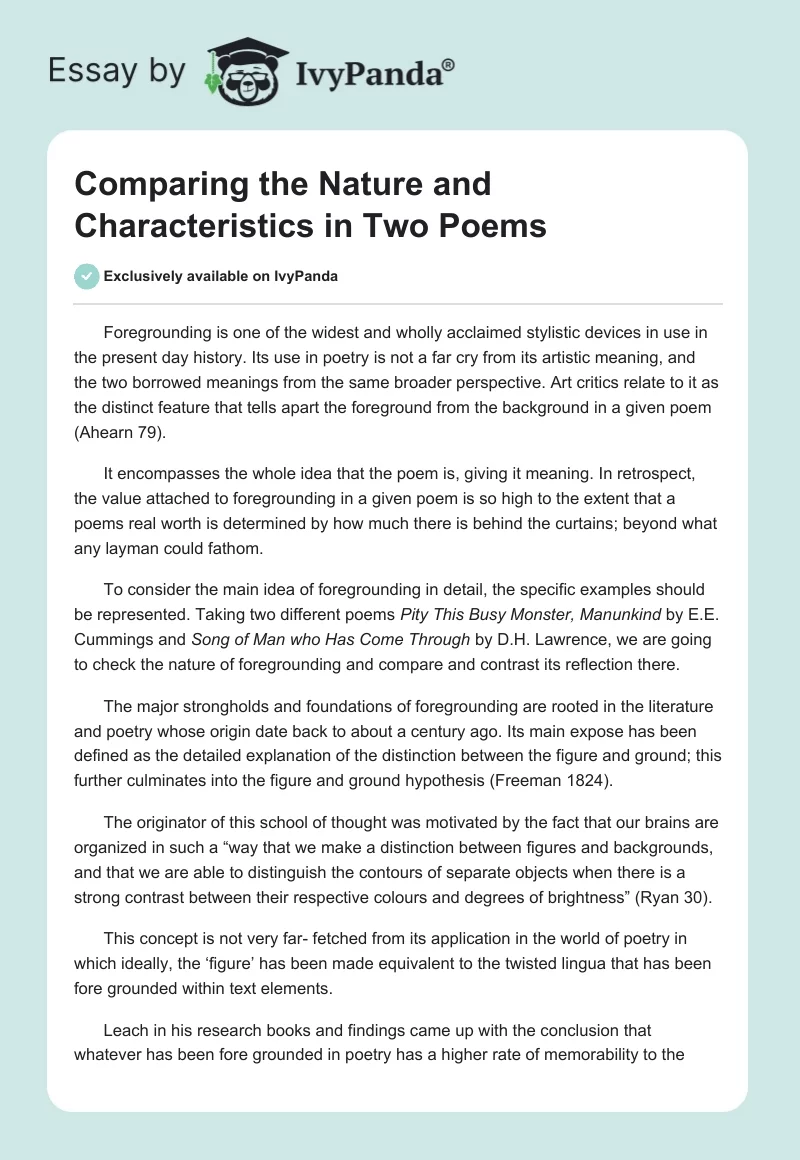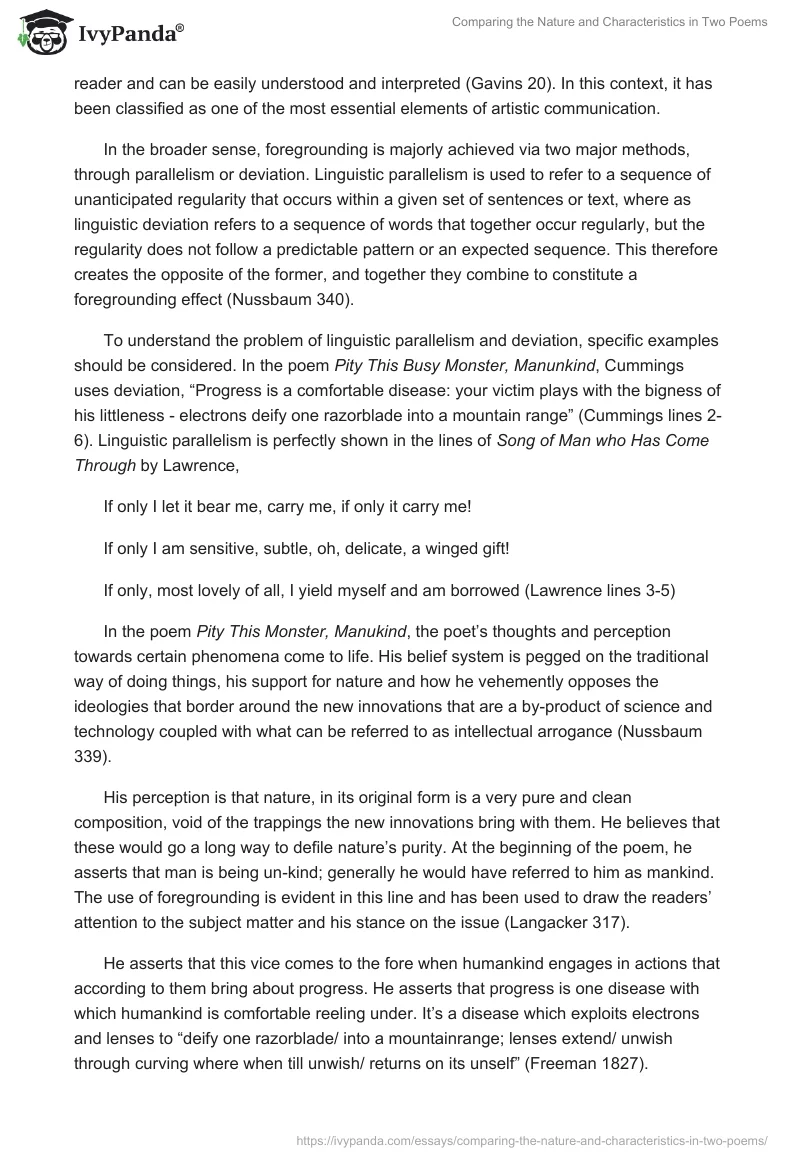Foregrounding is one of the widest and wholly acclaimed stylistic devices in use in the present day history. Its use in poetry is not a far cry from its artistic meaning, and the two borrowed meanings from the same broader perspective. Art critics relate to it as the distinct feature that tells apart the foreground from the background in a given poem (Ahearn 79).
It encompasses the whole idea that the poem is, giving it meaning. In retrospect, the value attached to foregrounding in a given poem is so high to the extent that a poems real worth is determined by how much there is behind the curtains; beyond what any layman could fathom.
To consider the main idea of foregrounding in detail, the specific examples should be represented. Taking two different poems Pity This Busy Monster, Manunkind by E.E. Cummings and Song of Man who Has Come Through by D.H. Lawrence, we are going to check the nature of foregrounding and compare and contrast its reflection there.
The major strongholds and foundations of foregrounding are rooted in the literature and poetry whose origin date back to about a century ago. Its main expose has been defined as the detailed explanation of the distinction between the figure and ground; this further culminates into the figure and ground hypothesis (Freeman 1824).
The originator of this school of thought was motivated by the fact that our brains are organized in such a “way that we make a distinction between figures and backgrounds, and that we are able to distinguish the contours of separate objects when there is a strong contrast between their respective colours and degrees of brightness” (Ryan 30).
This concept is not very far- fetched from its application in the world of poetry in which ideally, the ‘figure’ has been made equivalent to the twisted lingua that has been fore grounded within text elements.
Leach in his research books and findings came up with the conclusion that whatever has been fore grounded in poetry has a higher rate of memorability to the reader and can be easily understood and interpreted (Gavins 20). In this context, it has been classified as one of the most essential elements of artistic communication.
In the broader sense, foregrounding is majorly achieved via two major methods, through parallelism or deviation. Linguistic parallelism is used to refer to a sequence of unanticipated regularity that occurs within a given set of sentences or text, where as linguistic deviation refers to a sequence of words that together occur regularly, but the regularity does not follow a predictable pattern or an expected sequence. This therefore creates the opposite of the former, and together they combine to constitute a foregrounding effect (Nussbaum 340).
To understand the problem of linguistic parallelism and deviation, specific examples should be considered. In the poem Pity This Busy Monster, Manunkind, Cummings uses deviation, “Progress is a comfortable disease: your victim plays with the bigness of his littleness – electrons deify one razorblade into a mountain range” (Cummings lines 2-6). Linguistic parallelism is perfectly shown in the lines of Song of Man who Has Come Through by Lawrence,
If only I let it bear me, carry me, if only it carry me!
If only I am sensitive, subtle, oh, delicate, a winged gift!
If only, most lovely of all, I yield myself and am borrowed (Lawrence lines 3-5)
In the poem Pity This Monster, Manukind, the poet’s thoughts and perception towards certain phenomena come to life. His belief system is pegged on the traditional way of doing things, his support for nature and how he vehemently opposes the ideologies that border around the new innovations that are a by-product of science and technology coupled with what can be referred to as intellectual arrogance (Nussbaum 339).
His perception is that nature, in its original form is a very pure and clean composition, void of the trappings the new innovations bring with them. He believes that these would go a long way to defile nature’s purity. At the beginning of the poem, he asserts that man is being un-kind; generally he would have referred to him as mankind. The use of foregrounding is evident in this line and has been used to draw the readers’ attention to the subject matter and his stance on the issue (Langacker 317).
He asserts that this vice comes to the fore when humankind engages in actions that according to them bring about progress. He asserts that progress is one disease with which humankind is comfortable reeling under. It’s a disease which exploits electrons and lenses to “deify one razorblade/ into a mountainrange; lenses extend/ unwish through curving where when till unwish/ returns on its unself” (Freeman 1827).
This is one area where parallelism comes into light, depicting the efficiency with which the disease that is progress is seeping through their entire world. He further explains his reasons and understanding of how progress, in all its forms do not go hand in hand with nature. This is evident on the line, “A world of made/ is not a world of born”. The speakers tone is one representative of progress, but he still roots for nature’s place in the cycle that is life.
This is evident in one line when the speaker says that, “We doctors know a hopeless cause/ Hopelessness is the human cycle of progress. He however suggests a possible solution for all this when he claims to have an idea before the poem ends, he suggests the existence of another world beyond theirs’ (Emmott 121).
The difference between the two worlds arises from his assertion that the other world is a better hell than the one he or she lives in presently. He refers to this universe with negative terms like “unwish” and “unself” and the world beyond with positivity when he asserts that it is majorly composed of wishes and selves. These are real emotions encompassing real individuals; realities that be.
The pattern outlined in the poem is one where the poet creates the picture of a diminished natural setting that has been defiled by progress. As he concludes the poem, he refers to another world away to which he refers to as another hell, a reflection of the chaos the progress has created in their previously serene world (Fauconnier 21).
On the other hand, Lawrence’s poem The Song of a Man Who Has Come Through describes a human being as a delicate creature. Through time he becomes harder, turning into wedge blades. We are knocked into and placed into the chaos and confusion that characterize the world we live in. The deeper we get into the chaos as wedges, the further the split that is created on the chaos, altering our conditions and our states during creation. This is as a result of the wind that blows against us.
Having analysed the mood and general setting of the poems, it is high time to turn to the discussion of the foregrounding techniques used by the authors. It is important to mention that different kinds of foregrounding techniques help understand the poem better, they as if disclose the hidden idea of the problems and the issues the authors wanted to deliver to the readers.
It is important to mention that repetitions and parallelisms are very important in Lawrence’s Song of Man who Has Come Through. We have already mentioned the parallelisms the author uses in the poem, that is “if only”.
The whole text is abound with repetitions. Here are some specific examples, which help us understand some moments in the poem better. Using “Not I, not I” (Lawrence line 1) in the very beginning of the poem, the author as if tried to say that he was not the focus of the discussion. These words hint the reader that the poem is not autobiographical. The repetition of the word “fine” in the text is symbolical as the author tries to show that the changes which the wind brings are going to be positive.
The repetitions used in two last lines deserve our attention.
No, no, it is the three strange angels.
Admit them, admit them (Lawrence lines 17-18).
It is enough just to say “no”, but the author repeats it twice to show not just the rejection, but the absolute exclusion of the idea that it can be someone besides angels. The final line is the repetition which tries to deliver to the reader the positive nature of those angels and the necessity to allow them enter, in spite of the fact that the night is outside.
The main ideas and purposes of the repetition is this poem may be discussed perpetually. It is important to remember that they are aimed at showing the reader the author’s concerns and preferable relation to some events. Being a side observer (not the main hero of the poem), this way of participation seems the most appropriate.
Cummings’ poem Pity This Busy Monster, Manunkind seems to be a god example of the repetition in the sentences construction. At the poem beginning and at its end the author uses the same construction.
In the beginning of the poem we read
not. Progress is a comfortable disease:
your victim (death and life safely beyond)
plays with the bigness of his littleness
– electrons deify one razorblade
into a mountainrange; (Cummings line 2).
At the end of the poem the same construction
ultraomnipotence. We doctors know
a hopeless case if – listen: there’s a hell
of a good universe next door; (Cummings line 12).
This visual similarity may function as the reflection of the problem statement and the solution. The first part of the poem shows the problem which should be considered and the decision found. At the end of the poem the author as is sees the solution and to show that this specific information is the problem solution, he makes the same construction. It is also important to notice that fact that prosody is specific in this poem and the use o construction repetition adds to the effect of melody and rhyme.
Works Cited
Ahearn, Barry. Pound/Cummings: The correspondence of Ezra Pound and E. E. Cummings. Ann Arbor: University of Michigan Press, 1996. Print.
Emmott, Catherine. Narrative comprehension: A discourse perspective. Oxford: Oxford University Press, 1997. Print.
Fauconnier, Gilles. Mappings in thought and language. Cambridge: Cambridge University Press, 1997. Print.
Freeman, Margaret H. “Cognitive linguistic approaches to literary studies: State of the art in cognitive poetics.” Oxford Handbook of Cognitive Linguistics. Eds. Dirk Geeraerts and Hubert Cuyckens. Oxford: Oxford University Press, 2008. 1821-1866. Print.
Gavins, J. “Absurd tricks with bicycle frames in the text world of the third policeman.” Nottingham Linguistic Circular 15(2000): 17–33. Print.
Langacker, Ronald W. Foundations in cognitive grammar, Vol II: Descriptive application. Stamford, CA: Stanford University Press, 1991. Press.
Nussbaum, Martha Craven. The fragility of Goodness: Luck and ethics in Greek tragedy and philosophy. Cambridge: Cambridge University Press. 1986, Print.
Ryan, Marie-Laure. Possible worlds: Artificial intelligence and narrative theory. Bloomington and Indianapolis: Indiana University Press, 1991. Print.


